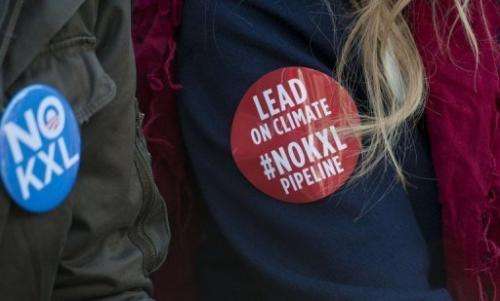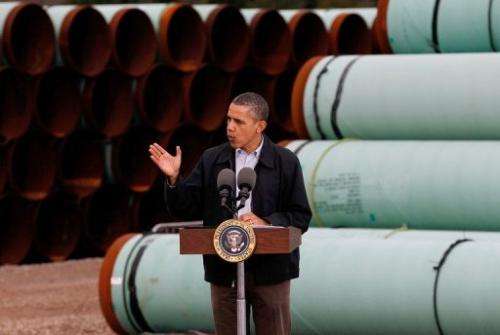US unveils Keystone pipeline environmental study

The US State Department suggested Friday that a $7 billion Canada-to-Texas oil pipeline would have no major impact on the environment, but stopped short of recommending it be approved.
The lengthy draft environmental impact statement examines how the Keystone XL Project could affect wildlife and surrounding areas as it crosses from the tar-sands of Alberta in Canada and travels 875 miles (1,050 kilometers) south.
The fate of the proposed pipeline, which many environmentalists fear could be damaging, is still awaiting approval from the State Department.
"The analyses of potential impacts associated with construction and normal operation of the proposed project suggest that there would be no significant impacts to most resources along the proposed Project route," the report said.
But it qualified its remarks by saying Keystone operators, TransCanada, would have to meet all the measures it has vowed to implement to mitigate any harm caused by the project.
The new report will launch a 45-day period for public comments, after which a final decision will be taken, US officials said.
"It really has no recommendations one way or the other. At this point we are looking at this very, very objectively" said Kerri-Ann Jones, assistant secretary for Oceans and International Environmental and Scientific Affairs.
"We want to make sure we serve the best interests of our country and so we are really taking a thorough look, and we waiting for everyone to comment and to give us their feed-back."
President Barack Obama denied approval for an initial project last year in part due to criticism in Nebraska, where the proposed route would have crossed an area of sensitive wetlands and extensive areas of shallow groundwater.
TransCanada submitted a new route which avoids that Sand Hills region, but still traverses an area known as the High Plains Aquifer. Nebraska lifted its objections to the pipeline in January.

Environmental groups however were angered Friday that the Keystone project was still on the table.
"Oil spills, environmental damage, wildlife put in harm's way, a doubling-down on the climate crisis: It's hard to understand why the Obama government is even considering this project," said Bill Snape, of the Center from Biological Diversity, in a statement.
He said that the existing Keystone 1 tar sands pipeline has leaked 14 times since it came into operation in June 2010, including one spill of some 24,000 gallons.
TransCanada has argued though that the project would bring much needed jobs and boost America's desire to be increasingly energy self-sufficient.
Canadian officials said they were reviewing the complex State Department document, but Natural Resources Minister Joe Oliver said the pipeline "will create tens of thousands of jobs on both sides of the border."
"This project will replace oil from Venezuela and the Middle East with a stable continental supply, including from the oil sands and improve the energy security of North America," he added in a statement.
Some 42,100 jobs would be created over the one-to-two year construction period, the US report said, leading to some $2.05 billion in earnings. In the long term the project would translate to some 35 to 50 permanent jobs.
The State Department's report found that "after construction, the proposed pipeline would not obstruct flows over designated floodplains" in Montana, South Dakota and Nebraska.
"Any changes to topography would be minimal and thus would not affect local flood dynamics or flood elevations," it said.
It did find however that 24 protected or threatened species, including the whooping crane and the greater sage grouse, could be hurt by the project due to habitat loss or reduced food.
The pipeline would also "adversely affect" the American burying beetle.
The pipeline would cross the US-Canada border at Morgan, Montana and then travel to Nebraska where it will join up with existing pipeline facilities to shepherd the oil onward to Oklahoma and Texas.
The technical review released on Friday did acknowledge that US water resources could be tainted if there were any oil spills.
"Releases could potentially impact open waterbodies such as rivers, lakes, and ponds, and the ecosystems that rely on them," the report said.
But it stressed "spills associated with the proposed project that enter the environment are expected to be rare and relatively small."
(c) 2013 AFP





















